Naming carboxylic acids - Study guides, Class notes & Summaries
Looking for the best study guides, study notes and summaries about Naming carboxylic acids? On this page you'll find 60 study documents about Naming carboxylic acids.
Page 4 out of 60 results
Sort by
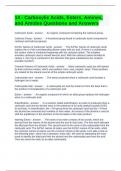
-
14 - Carboxylic Acids, Esters, Amines, and Amides Questions and Answers
- Exam (elaborations) • 3 pages • 2024
- Available in package deal
-
- $13.99
- + learn more
14 - Carboxylic Acids, Esters, Amines, and Amides Questions and Answers Carboxylic Acids An organic compound containing the carboxyl group. Carboxyl Group A functional group found in carboxylic acids composed of carbonyl and hydroxyl groups. Previous Play Next Rewind 10 seconds Move forward 10 seconds Unmute 0:08 / 0:15 Full screen Brainpower Read More IUPAC Names of Carboxylic Acids The IUPAC names of carboxylic acids replace the e of the corresponding alkane nam...
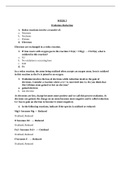
-
CHEM 120 Week 5 Oxidation Reduction Questions and Answers- Chamberlain College Atlanta
- Exam (elaborations) • 20 pages • 2023
- Available in package deal
-
- $15.98
- + learn more
CHEM 120 Week 5 Oxidation Reduction Questions and Answers- Chamberlain College Atlanta WEEK 5 Oxidation-Reduction 1. Redox reactions involve a transfer of: a. Neutrons b. Nucleons c. Protons d. Electrons Electrons are exchanged in a redox reaction. 2. If iron reacts with oxygen gas in the reaction 2 Fe(s) + O2(g) → 2 FeO(s), what is oxidized in this reaction? a. O2 b. No oxidation is occurring here c. FeO d. Fe In a redox reaction, the atom being oxidized often accepts an oxygen...
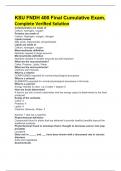
-
KSU FNDH 400 Final Cumulative Exam, Complete Verified Solution
- Exam (elaborations) • 53 pages • 2024
- Available in package deal
-
- $27.89
- + learn more
KSU FNDH 400 Final Cumulative Exam, Complete Verified Solution Carbohydrates are made of Carbon, hydrogen, oxygen Proteins are made of Carbon, Hydrogen, oxygen, nitrogen Lipids include fatty acids, triglycerides, phospholipids Lipids are made of Carbon, hydrogen, oxygen Macronutrients definition Nutrients needed in large amounts Micronutrients definition Nutrients needed in smaller amounts but still important What are the macronutrients? Carbs, Proteins, Lipids, Water What are the...

-
CHEM 104 EXAM QUESTIONS AND ANSWERS 100% COMPLETE TEST SOLUTIONS A+ GRADED
- Exam (elaborations) • 42 pages • 2024
-
- $12.49
- + learn more
CHEM 104 EXAM QUESTIONS AND ANSWERS 100% COMPLETE TEST SOLUTIONS A+ GRADED Tertiary alcohols cannot be oxidized because ________. Select one: A. there are no hydrogen atoms attached to the alcohol carbon B. the alcohol carbon is too electronegative to have hydrogen removed from it C. the alcohol carbon is bonded to four groups so no hydrogen can be added to it D. there are no oxygen atoms to remove from the alcohol carbon E. the alcohol carbon is bonded to ...

-
Chemistry 121 Exam #1 Study guide 2023/2024
- Exam (elaborations) • 6 pages • 2023
- Available in package deal
-
- $12.99
- + learn more
Covalent Bonding Naming - ANSWERS Use prefixes to show how many atoms of each element are present. Example: SO2 Sulfur dioxide Acids - ANSWERS Compounds in which the cation is H+; usually drop "Hydrogen" in acid name Hydrates - ANSWERS Same rule for ionic compound naming + number of water + hydrate Example: CuSo4 x 5H20 = Copper (II) Sulfate Pentahydrate Alcohol - ANSWERS Any organic compound with hydroxyl functional group (-OH) bound to a carbon atom Carboxylic Acid - ANSWERS Pr...
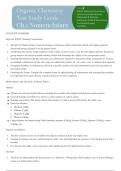
-
Organic chemistry test study guide for iupac naming conventions hydrocarbons alcohols aldehydes ketones carboxylic acids derivatives functional groups concept summary good for mcat pre
- Class notes • 3 pages • 2024
- Available in package deal
-
- $9.64
- + learn more
Organic Chemistry Test Study Guide: IUPAC Naming Conventions Hydrocarbons Alkanes: Saturated hydrocarbons with single bonds (C-C). Named using the suffix “-ane” (e.g., methane, ethane). Alkenes: Unsaturated hydrocarbons with at least one double bond (C=C). Named using the suffix “-ene” (e.g., ethene, propene). Alkynes: Unsaturated hydrocarbons with at least one triple bond (C≡C). Named using the suffix “-yne” (e.g., ethyne, propyne). Alcohols Contain a hydroxyl group (-...
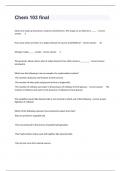
-
Chem 103 final Exam Questions And Well Elaborated Answers.
- Exam (elaborations) • 25 pages • 2024
- Available in package deal
-
- $15.49
- + learn more
Atoms are made up of protons, neutrons and electrons. The charge on an electron is ____. - correct answer -1 How many atoms are there in a single molecule of sucrose (C12H22O11)? - correct answer 45 Nitrogen makes _____ bonds - correct answer 3 The geometry about carbon when it makes bonds to four other atoms is ________ - correct answer tetrahedral Which one the following is not an example of a condensation reaction? -The reaction of glucose and fructose to form...
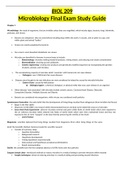
-
BIOL 209 Microbiology Final Exam Study Guide
- Exam (elaborations) • 60 pages • 2022
-
- $21.49
- + learn more
BIOL 209 Microbiology Final Exam Study Guide Chapter 1 Microbiology- the study of organisms, that are invisible unless they are magnified, which include algae, bacteria, fungi, helminths, protozoa, and viruses Bacteria are ubiquitous- they are everywhere including deep within the earth, in oceans, and on polar ice caps, and within plant and animal “bodies” Oceans are mostly populated by bacteria Our ocean’s most abundant inhabitants are viruses Microbes are beneficia...

-
(I)GCSE Chemistry Notes Bundle
- Other • 68 pages • 2024
-
- $25.49
- + learn more
These notes are all you need to achieve those top grades in your exams! - For the new IGCSE/GCSE Chemistry syllabus (based on the 9-1 IGCSE Edexcel Chemistry syllabus, but also suitable for other exam boards) - Suitable for higher/foundation - 68 pages of concise notes & diagrams (no unnecessary waffling commonly seen in textbooks) - Grade 9 achieved - Topics included: states of matter, solubility, elements/compounds/mixtures, methods of separation, atomic structure, periodic table, chem...

-
NOMENCLATURE & CLASSIFICATION OF ORGANIC COMPOUND
- Class notes • 83 pages • 2024
-
- $8.39
- + learn more
Definition of organic compounds: What are they, and what makes them different from inorganic compounds? Classification of organic compounds: Based on carbon skeleton (aliphatic, aromatic, alicyclic) Based on functional groups (alcohols, aldehydes, ketones, carboxylic acids, etc.) Based on structure (cyclic, acyclic, branched, straight chain) IUPAC nomenclature: Rules for naming different types of organic compounds Identification of parent chain, functional groups, and substituents Numb...

How did he do that? By selling his study resources on Stuvia. Try it yourself! Discover all about earning on Stuvia


